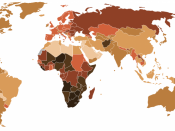Nepal, Asia, a devolving country other organization have intervening to help Nepal from further devastating their biodiversity.
Nepal is located between India and China, landlocked area. Land is divided into five physiographic regions; Tarai, Siwaliko, middle mountains, high mountains, and high himal. Around the world the problem of melting glaciers, NepalÃÂs mountain range is no different. Nepal is seeing glaciers shrinking at dramatic rates, causing flooding and avalanches. Melt water disappears and climate change progresses, agricultural productivity that is dependent on the water source will go down (Conservation). This will threaten food productivity for those who live in the valleys below major mountain ranges.
One major concern is that NepalÃÂs population has already maximum its land area. 70 percent of the population was of working age and 91 percent employment structure was engaged in agriculture and allied activities. Families consisting of 5.8 people per family, children born were put to work in the fields.
Fertility and mortality rate according to estimates made by the Central Bureau of Statistics is the crude birthrate was 44 per 1,000, and the crude death rate was almost 14 per 1,000 (Congress Country). This is a clear indication of the lack of health services and was high compared to other Asian countries. Over population takes its toll of natural resources such as wood.
By 1980 Nepal lost half of its forest cover. From the increase of the population and wood being their fuel and building source the forest of Nepal is in trouble. The problem was no alternative source of energy. Deforestation brings socio-economic and environmental problem in Nepal. After deforestation other problem occurred, such as land slides, flood, forest fire and shortage of firewood, timber, fodder, grass, livestock bedding and compost for the farming in the locality (Joshi). Problems that can accrue are as...


